HP 15 (15-dw1000) review – you get a lot for such a low price
 Updated, refreshed or renewed? Probably all of this at once. The HP 15 (15-dw1000) is a fresh laptop from the American company, which finally provides a sleek look in 2020. Instead of its thick bezels and flimsy plastic design, the company has gone for a tighter package that houses decent hardware and an optional 1080p IPS display.
Updated, refreshed or renewed? Probably all of this at once. The HP 15 (15-dw1000) is a fresh laptop from the American company, which finally provides a sleek look in 2020. Instead of its thick bezels and flimsy plastic design, the company has gone for a tighter package that houses decent hardware and an optional 1080p IPS display.
In a way, most of the affordable all-rounders on the market provide a similar experience. However, the differences lie in the details. And more frequently, this refers to the failure to accomplish a good build quality or to provide a decent battery life, mainly because of the cost-cutting measures. How much of a compromise was made with this model? Let’s find out.
You can check the prices and configurations in our Specs System: https://laptopmedia.com/series/hp-15-15-dw0000-dw1000-dw2000/
Contents
Specs Sheet
- CPU
- Intel Pentium Silver N5030 #236 en Top CPUs Intel Core i7-1255U #163 en Top CPUs Intel Core i5-1135G7 #200 en Top CPUs Intel Core i3-1125G4 #199 en Top CPUs Intel Core i3-1115G4 #216 en Top CPUs Intel Celeron N4500 #243 en Top CPUs Intel Celeron N4120 #239 en Top CPUsIntel Pentium Gold 6405U Intel Core i5-8265U
- GPU
- Intel UHD Graphics Xe G4 (48EU) #259 en Top GPUs Intel UHD Graphics 605 #272 en Top GPUs Intel UHD Graphics 600 #273 en Top GPUs Intel UHD Graphics (Jasper Lake 16 EU) #265 en Top GPUs Intel UHD Graphics #269 en Top GPUs Intel Iris Xe Graphics G7 (96EU) #232 en Top GPUs Intel Iris Xe Graphics G7 (80EU) #240 en Top GPUsIntel UHD Graphics 620
- HDD/SSD
- hasta 4000GB SSD
- Ranura M.2
- 1x 2280 PCIe NVMe 3.0 x2 Ver foto
- RAM
- up to 64GB
- OS
- Windows 10 Home, Windows 11 Home, Windows 10 Pro, Windows 11 Pro
- Batería
- 41Wh, 3-cell, 41Wh
- Material del cuerpo
- Plastic / Polycarbonate
- Dimensiones
- 358.5 x 242 x 19.9 mm (14.11" x 9.53" x 0.78")
- Peso
- 1.75 kg (3.9 lbs)
- Puertos y conectividad
- 1x USB Type-C
- 3.2 Gen 1 (5 Gbps)
- 2x USB Type-A
- 3.2 Gen 1 (5 Gbps)
- HDMI
- 1.4b
- Lector de tarjetas
- SD, SDHC, SDXC
- Ethernet LAN
- 10, 100, 1000 Mbit/s
- Wi-Fi
- 802.11ac
- Bluetooth
- 4.2
- Conector de audio
- 3.5 mm combo
- Features
- Lector de huellas dactilares
- optional
- Cámara web
- HP TrueVision HD
- Teclado retroiluminado
- optional
- Micrófono
- Digital dual-array microphones
- Altavoces
- Stereo Speakers
- Unidad óptica
- Ranura de bloqueo de seguridad
Todo HP 15 (15-dw0000, dw1000, dw2000, dw3000, gw0000, gr0000, du0000, du1000, du2000, du3000) configuraciones
What’s in the box?
This device comes with a 45W power unit inside the box.
Design and construction
So, what should you expect when you get this device? Well, an all-plastic build of course. Its quality is … not terrible, but the weight is only 1.74 kg, while the profile stands at 19.9mm. The finish on the lid surface is matte, and that of the base appears like a brushed-like paint job.
Interestingly, the lid does open with a single hand. It has narrow side bezels and the top one houses the camera unit. There is also a slight notch, helping you to grip the lid while opening. All of this sounds really good, but when it comes to structural integrity, things start to look ugly. First, the entire lid bends like a madman, and second – severe ghosting occurs while you do so.
Then, at the base, we see a large grill, hiding the speakers. Good decision from HP to make them fire towards the user, rather than fade away at the desk. Beneath the speaker grill, you’ll see the keyboard, which has a full-size NumberPad section. Its key travel is good, and the feedback is clicky. Sadly, it comes without a backlight, but the grey color of the keys is far more “darkness-friendly” than the black. The only issue we have with this unit is the size of the “Up” and “Down” arrow keys.
Further down below, you can see the touchpad, which has its own dedicated buttons. They are a little hard to click, but it’s not a big issue. The surface of the touchpad is quite wide, and the overall area is good-enough for a Windows laptop. As of the tracking – well, it feels a bit slow, to be honest.
Additionally, there is a fingerprint reader on the bottom right side of the base, which is a very rare feature on budget notebooks.
Lastly, there is the bottom panel, which only houses the ventilation grills. There was no surprise when we found out that the hot air escapes the chassis from in between the lid and the base.
Ports
On the left side, you’ll find an RJ-45 connector, an HDMI port, a USB Type-C 3.1 (Gen. 1) port, and an audio jack. Then, on the right, there is the power plug, two USB Type-A 3.1 (Gen. 1) ports, and an SD card reader – not bad for a budget machine.
Disassembly, upgrade options and maintenance
Every now and then, HP produces a laptop that has all its screws visible to the naked eye. However, this device is not one of them. In order to unravel all of them, you need to remove both of the rubber feet. They hide five of the seven total Phillips-head screws. Once you’ve removed all of them, you can start prying the bottom panel. You can either do so by gently lifting the base from the lid, or you can turn the laptop around. Whatever is more comfortable for you.
In terms of cooling, we see a single heat pipe with quite a narrow diameter. However, we are glad to see conventional cooling, rather than a one with the metal plate-no fan black wizardry.
Interestingly, this budget machine offers a lot of upgradability options. There are two RAM SODIMMs, which support up to 16GB of DDR4 memory in dual channel. As of the storage, there is one M.2 slot, able to fit both SATA and PCIe x2 drives. Not that it affects its performance, but it looks weird, being placed at a slight angle. Next, there is a 2.5-inch SATA drive bay for your music or movie libraries.
Should you need to stay away from the plug, there is a 41Wh battery, that will power the laptop.
Display quality
HP 15 (15-dw1000) is equipped with a Full HD IPS panel, model number AUO B156HAN02.1 (AUO21ED). Its diagonal is 15.6″ (39.62 cm), and the resolution – 1920 х 1080p. Additionally, the screen ratio is 16:9, the pixel density – 142 ppi, their pitch – 0.18 x 0.18 mm. The screen can be considered Retina when viewed from at least 60 cm (from this distance, the average human eye can’t see the individual pixels).
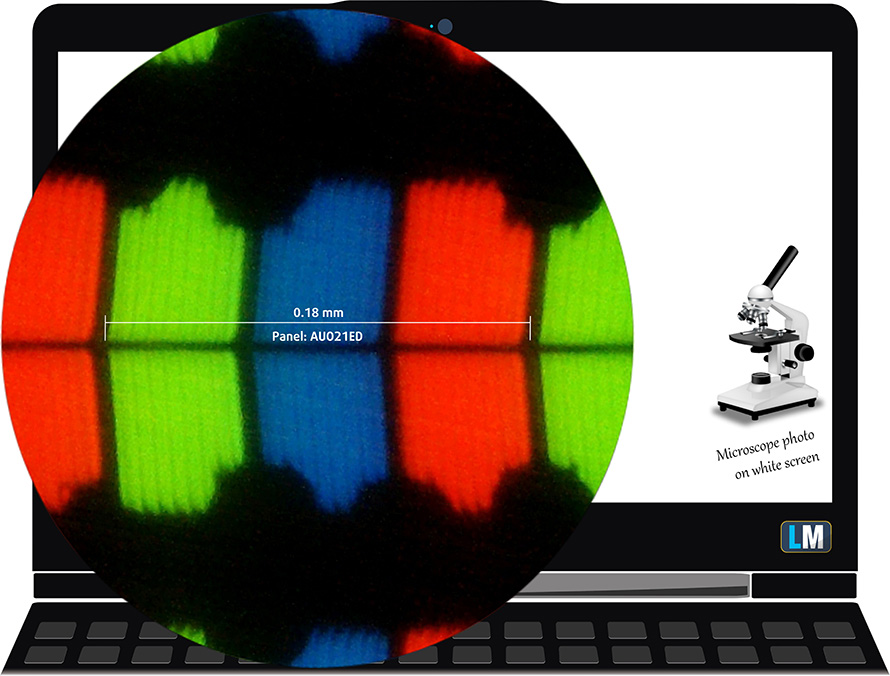
Viewing angles are good. We offer images at different angles to evaluate the quality.

The maximum measured brightness is 285 nits (cd/m2) in the middle of the screen and 270 nits (cd/m2) average across the surface with a maximum deviation of 8%. The Correlated Color Temperature on a white screen and at maximum brightness is 6460K (average) – practically matching the 6500K optimum for sRGB. The average color temperature through the grey scale before profiling is 6200K.
In the illustration below you can see how the display performs from uniformity perspective. The illustration below shows how matters are for operational brightness levels (approximately 140 nits) – in this particular case at 67% Brightness (White level = 140 cd/m2, Black level = 0.1 cd/m2).
Values of dE2000 over 4.0 should not occur, and this parameter is one of the first you should check if you intend to use the laptop for color-sensitive work (a maximum tolerance of 2.0 ). The contrast ratio is very good – 1400:1.
To make sure we are on the same page, we would like to give you a little introduction to the sRGB color gamut and the Adobe RGB. To start, there’s the CIE 1976 Uniform Chromaticity Diagram that represents the visible specter of colors by the human eye, giving you a better perception of the color gamut coverage and the color accuracy.
Inside the black triangle, you will see the standard color gamut (sRGB) that is being used by millions of people in HDTV and on the web. As for the Adobe RGB, this is used in professional cameras, monitors, etc for printing. Basically, colors inside the black triangle are used by everyone and this is the essential part of the color quality and color accuracy of a mainstream notebook.
Still, we’ve included other color spaces like the famous DCI-P3 standard used by movie studios, as well as the digital UHD Rec.2020 standard. Rec.2020, however, is still a thing of the future and it’s difficult for today’s displays to cover that well. We’ve also included the so-called Michael Pointer gamut, or Pointer’s gamut, which represents the colors that naturally occur around us every day.
The yellow dotted line shows HP 15 (15-dw1000)’s color gamut coverage.
Its display covers 52% of the sRGB/ITU-R BT.709 (web/HDTV standard) in CIE1976.
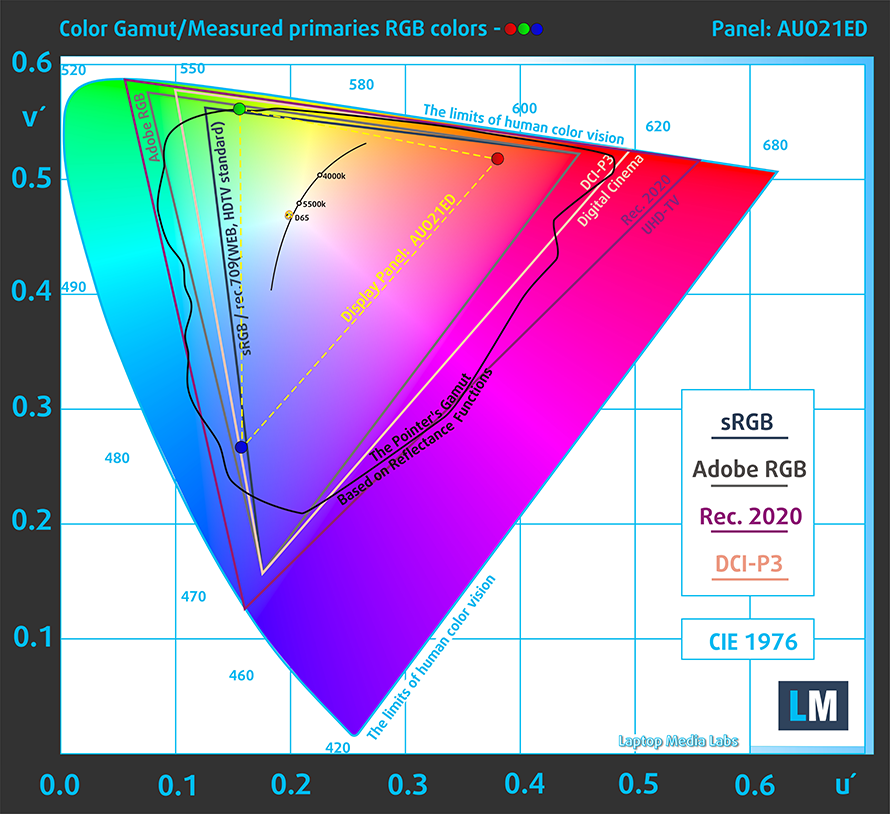
Our “Design and Gaming” profile delivers optimal color temperature (6500K) at 140 cd/m2 luminance and sRGB gamma mode.
We tested the accuracy of the display with 24 commonly used colors like light and dark human skin, blue sky, green grass, orange, etc. You can check out the results at factory condition and also, with the “Design and Gaming” profile.
Below you can compare the scores of HP 15 (15-dw1000) with the default settings (left), and with the “Gaming and Web design” profile (right).

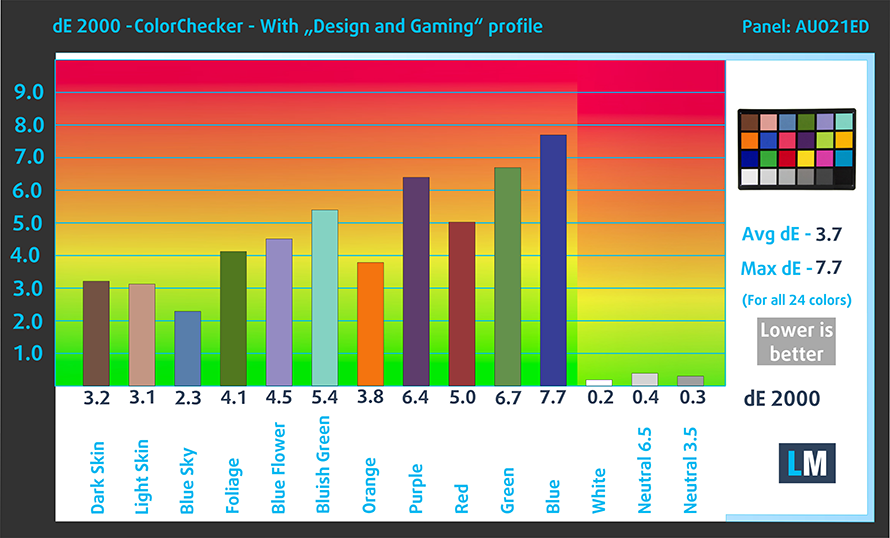
The next figure shows how well the display is able to reproduce really dark parts of an image, which is essential when watching movies or playing games in low ambient light.
The left side of the image represents the display with stock settings, while the right one is with the “Gaming and Web Design” profile activated. On the horizontal axis, you will find the grayscale and on the vertical axis – the luminance of the display. On the two graphs below you can easily check for yourself how your display handles the darkest nuances but keep in mind that this also depends on the settings of your current display, the calibration, the viewing angle, and the surrounding light conditions.
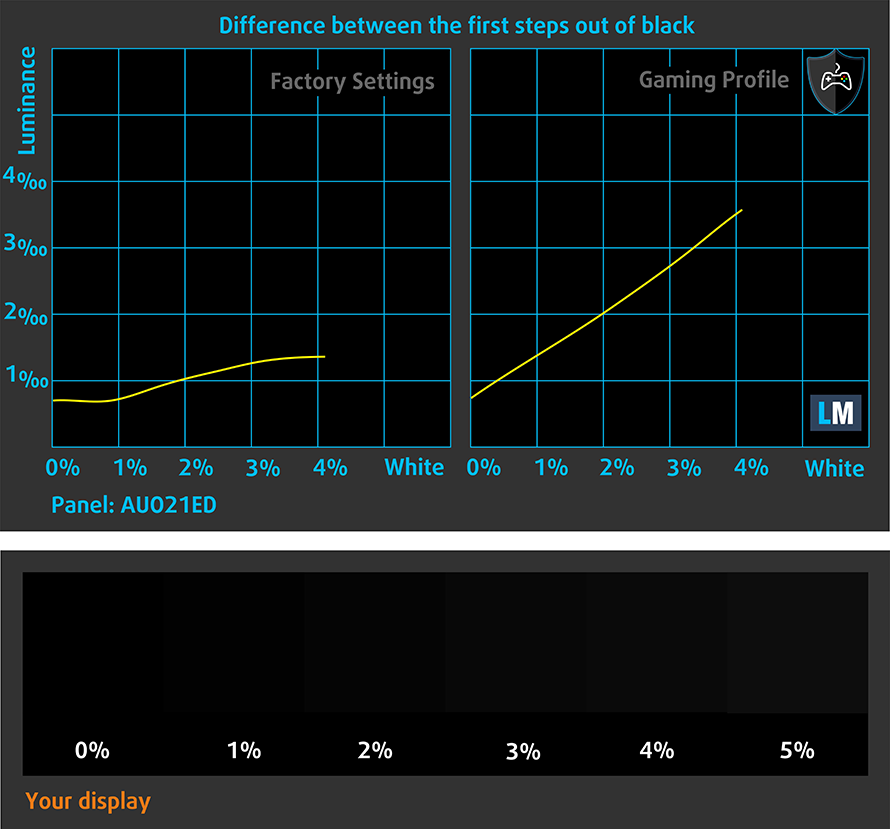
Response time (Gaming capabilities)
We test the reaction time of the pixels with the usual “black-to-white” and “white-to-black” method from 10% to 90% and vice versa.
We recorded Fall Time + Rise Time = 26 ms.
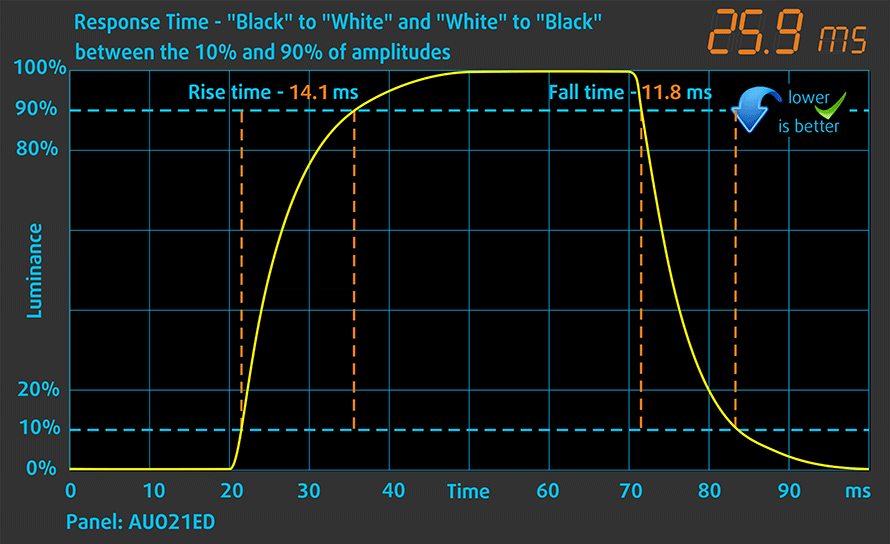
Health impact – PWM / Blue Light
PWM (Screen flickering)
Pulse-width modulation (PWM) is an easy way to control monitor brightness. When you lower the brightness, the light intensity of the backlight is not lowered, but instead turned off and on by the electronics with a frequency indistinguishable to the human eye. In these light impulses, the light/no-light time ratio varies, while brightness remains unchanged, which is harmful to your eyes. You can read more about that in our dedicated article on PWM.
HP 15 (15-dw1000)’s display doesn’t use PWM to adjust its brightness levels at any point. This makes it comfortable for long use periods, without harming your eyes in this aspect.
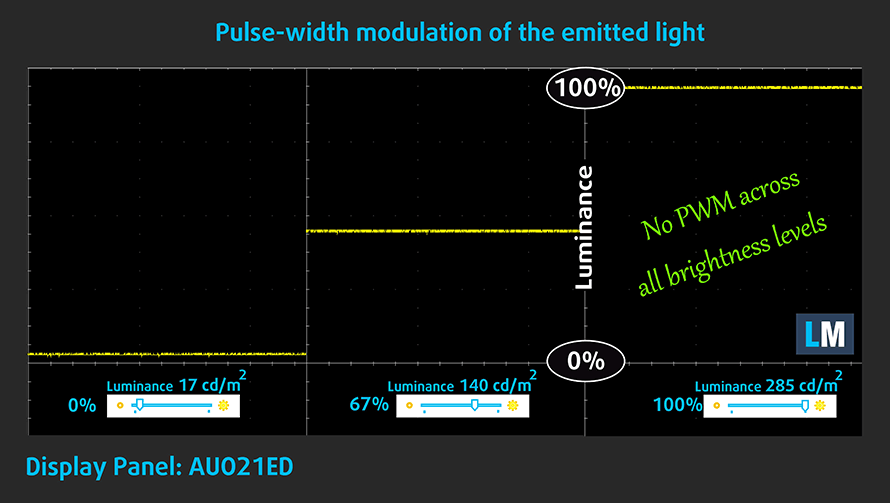
Blue light emissions
Installing our Health-Guard profile not only eliminates PWM but also reduces the harmful Blue Light emissions while keeping the colors of the screen perceptually accurate. If you’re not familiar with the Blue light, the TL;DR version is – emissions that negatively affect your eyes, skin, and your whole body. You can find more information about that in our dedicated article on Blue Light.
Conclusions
So what do you get with this one – essentially, the same display as the ProBook 450 G7. It has a Full HD resolution, IPS panel, comfortable viewing angles, and a good contrast ratio. Additionally, it lacks PWM, which makes it comfortable for long sessions of work or movies, even in the night. Sadly, its main disadvantage lies in the color reproduction – it is able to cover only 52% of sRGB.
Buy our profiles
Since our profiles are tailored for each individual display model, this article and its respective profile package are meant for HP ProBook 450 G7 configurations with 15.6″ AUO B156HAN02.1 (AUO21ED), (FHD, 1920 × 1080) IPS.
*Should you have problems with downloading the purchased file, try using a different browser to open the link you’ll receive via e-mail. If the download target is a .php file instead of an archive, change the file extension to .zip or contact us at [email protected].
Read more about the profiles HERE.
Además de recibir perfiles eficientes y respetuosos con la salud, al comprar los productos de LaptopMedia también apoyas el desarrollo de nuestros laboratorios, donde probamos los dispositivos para elaborar las reseñas más objetivas posibles.

Trabajo de oficina
El perfil Trabajo de Oficina debería ser utilizado sobre todo por usuarios que pasan la mayor parte del tiempo mirando trozos de texto, tablas o simplemente navegando. Este perfil pretende ofrecer una mayor nitidez y claridad manteniendo una curva de gamma plana (2,20), una temperatura de color nativa y colores perceptualmente precisos.

Diseño y juego
Este perfil está dirigido a los diseñadores que trabajan con los colores de forma profesional, y también para juegos y películas. Design and Gaming lleva a los paneles de visualización a sus límites, haciéndolos tan precisos como sea posible en el estándar sRGB IEC61966-2-1 para Web y HDTV, en el punto blanco D65.

Salud-Guardia
Salud-Guardia elimina la perjudicial Modulación de Ancho de Pulso (PWM) y reduce la luz azul negativa que afecta a nuestros ojos y a nuestro cuerpo. Al estar adaptado a cada panel, consigue mantener los colores perceptivamente precisos. Salud-Guardia simula el papel, por lo que la presión sobre los ojos se reduce considerablemente.
Consigue los 3 perfiles con un 33% de descuento
Sound
HP 15 (15-dw1000)’s speakers produce a relatively loud sound with decent quality. Its low, mid, and high tones are clear of deviations.
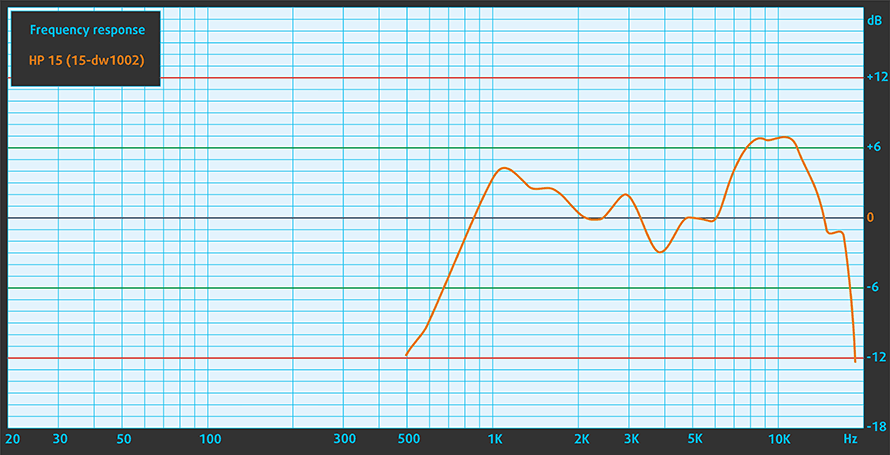
Drivers
All of the drivers and utilities for this notebook can be found here: https://support.hp.com/us-en/drivers/selfservice/hp-15-dw1000-laptop-pc-series/29159332
Battery
Now, we conduct the battery tests with Windows Better performance setting turned on, screen brightness adjusted to 120 nits, and all other programs turned off except for the one we are testing the notebook with. The battery life here was pretty average – we got 6 hours and 40 minutes of Web browsing and 6 hours and 33 minutes of video playback.
Para simular las condiciones de la vida real, utilizamos nuestro propio script de navegación automática por más de 70 sitios web.
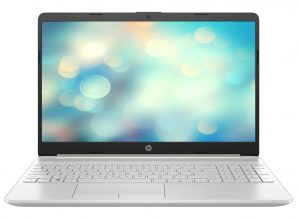

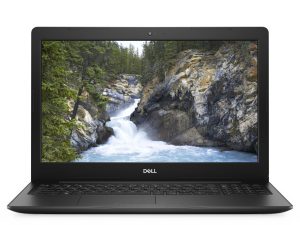
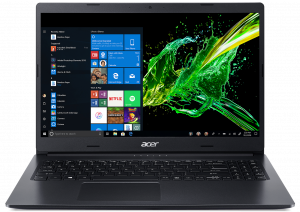
Para cada prueba de este tipo, utilizamos el mismo vídeo en HD.




CPU options
This device can be configured with a whole load of processor options. Some of them include the Core i3-8145U, Core i5-8265U, Core i7-8565U, Core i3-10110U, the Core i7-10510U and many more.A
Los resultados proceden de la prueba de CPU Cinebench 20 (cuanto mayor sea la puntuación, mejor)
Los resultados proceden de nuestra prueba de referencia de Photoshop (cuanto más baja sea la puntuación, mejor)
GPU options
In terms of the graphics, everything here is soldered to the processor, meaning there are no dedicated GPU options.
Los resultados proceden de la prueba 3DMark: Time Spy (Graphics) (cuanto mayor sea la puntuación, mejor)
Los resultados proceden de la prueba 3DMark: Fire Strike (Graphics) (cuanto mayor sea la puntuación, mejor)
Los resultados proceden de la prueba comparativa Unigine Superposition (cuanto mayor sea la puntuación, mejor)
Temperatures and comfort
Max CPU load
In this test we use 100% on the CPU cores, monitoring their frequencies and chip temperature. The first column shows a computer’s reaction to a short load (2-10 seconds), the second column simulates a serious task (between 15 and 30 seconds), and the third column is a good indicator of how good the laptop is for long loads such as video rendering.
Average core frequency (base frequency + X); CPU temp.
| Intel Core i3-10110U (15W TDP) | 0:02 – 0:10 sec | 0:15 – 0:30 sec | 10:00 – 15:00 min |
|---|---|---|---|
| HP 15 (15-dw1000) | 2.79 GHz (B+33%) @ 75°C | 2.72 GHz (B+30%) @ 76°C | 2.68 GHz (B+28%) @ 68°C |
| Dell Vostro 3590 | 3.32 GHz (B+58%) @ 95°C | 3.27 GHz (B+56%) @ 97°C | 2.73 GHz (B+30%) @ 84°C |
As you can see, HP has gone for a more conservative approach, favoring less noise and heat, instead of performance. Interestingly, the cooling solution has more potential than the Vostro 3590, as the frequencies at the end of the test are barely 50 MHz away, but the temperature advantage, the HP 15 has is huge – 16C.
Comfort during full load
This device runs quiet and cool under heavy load. We measured a maximum temperature on the base of no more than 36C.
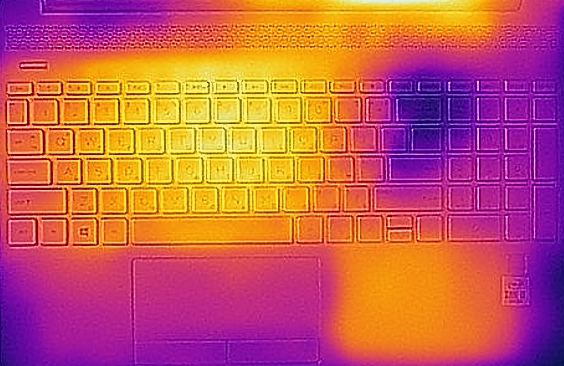
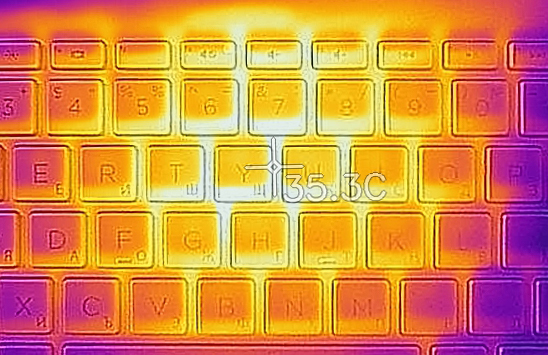
Verdict
 What actually happened today, guys is that we just confirmed what we expected – the biggest drawback of a laptop at this price is its build quality. Not that it’s bad, by the way. It is actually just a hair away from being decent. If it wasn’t for the cheap plastic material used, which is certainly going to be scratched after you sneeze at it.
What actually happened today, guys is that we just confirmed what we expected – the biggest drawback of a laptop at this price is its build quality. Not that it’s bad, by the way. It is actually just a hair away from being decent. If it wasn’t for the cheap plastic material used, which is certainly going to be scratched after you sneeze at it.
However, it is very rare to see an IPS panel and a fingerprint reader in this price category, and with a keyboard that good, we can confidently forgive it for lacking a backlight. Moreover, you have two RAM SODIMM slots for upgrades (although it can hold up to 16GB of DDR4 memory). And yep, there is an M.2 slot for fast storage, as well. And if you have a large movie or music library – there is a 2.5″ SATA drive bay for both HDDs and SSDs.
That’s not it, though. The port selection here is more than decent – two USB Type-A 3.1 (Gen. 1) ports, an RJ-45 connector, an HDMI connector, a USB Type-C port, and an SD card reader. Yes, the Type-C port is 3.1 (Gen. 1), meaning you won’t be connecting an external GPU to it, but you can still plug your smartphone or an accessory.
So what do you get with this one, when it comes to the display – essentially, the same display as the ProBook 450 G7. It has a Full HD resolution, IPS panel, comfortable viewing angles, and a good contrast ratio. Additionally, it lacks PWM, which makes it comfortable for long sessions of work or movies, even in the night. Sadly, its main disadvantage lies in the color reproduction – it is able to cover only 52% of sRGB.
At the end of the day, most of the downsides become irrelevant. If you need a laptop with the only purpose of daily driving it, or just watching a movie or two – well, this is a good choice. Just keep in mind that the battery life is not staggering – we got 6 hours and 40 minutes of Web browsing and roughly 10 minutes less when watching videos.
Pros
- Comfortable keyboard
- Thin and light design
- Decent I/O
- Adequate pricing
- Doesn’t use PWM for brightness adjustment
- Comfortable viewing angles and good contrast ratio
- It is equipped with an SD card and has great upgradability
- Has an optional fingerprint reader
Cons
- Plastic is the only material for the body
- Covers only 52% of sRGB
- No keyboard backlight
You can check the prices and configurations in our Specs System: https://laptopmedia.com/series/hp-15-15-dw0000-dw1000-dw2000/
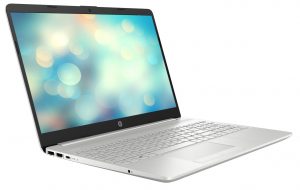

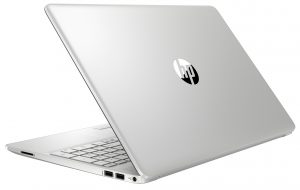
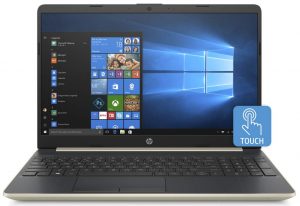
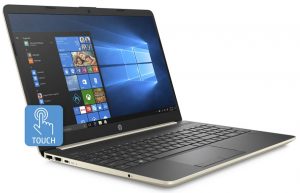
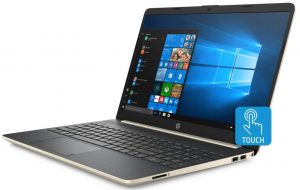
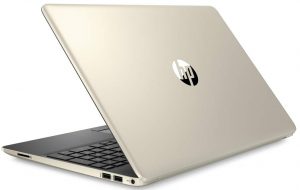


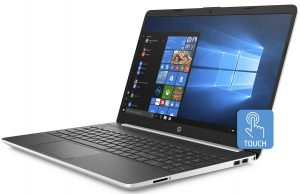
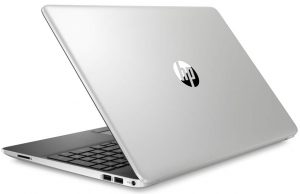
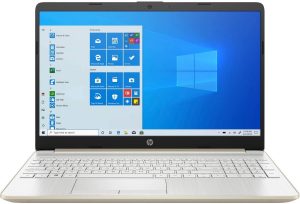

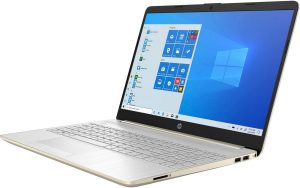
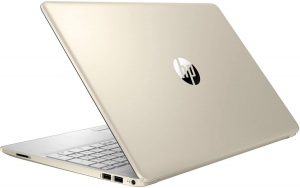
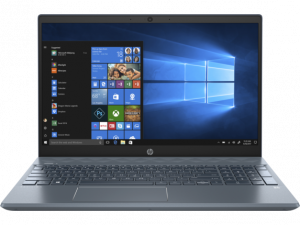
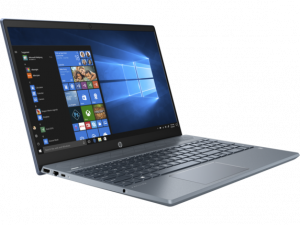
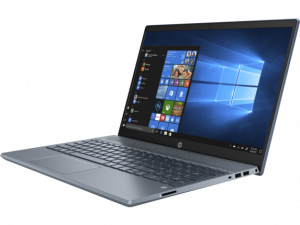
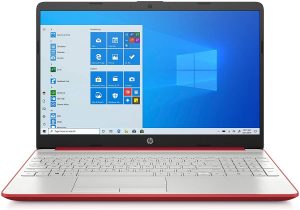
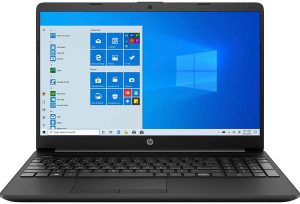
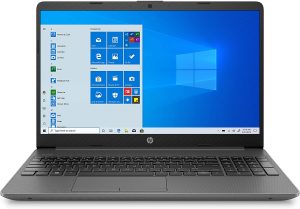

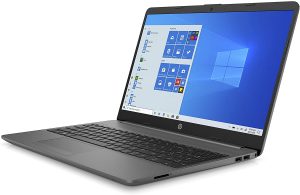
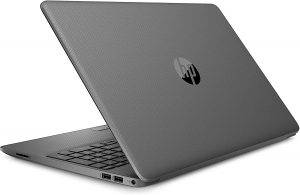
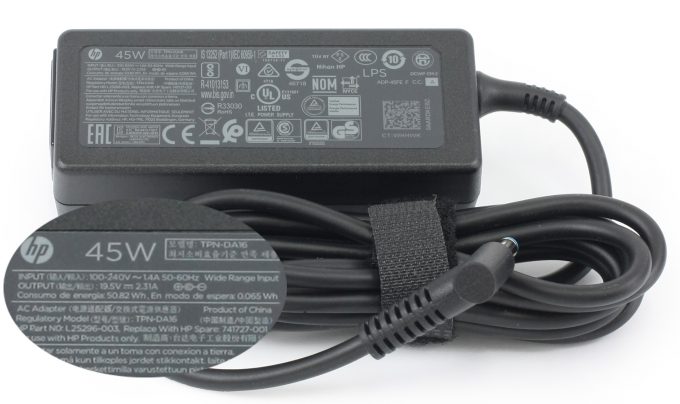
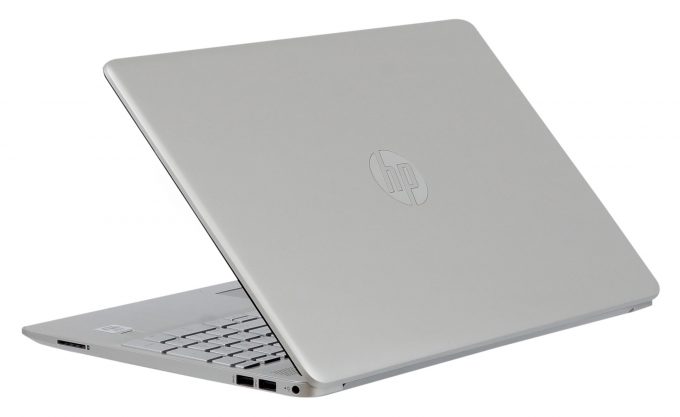

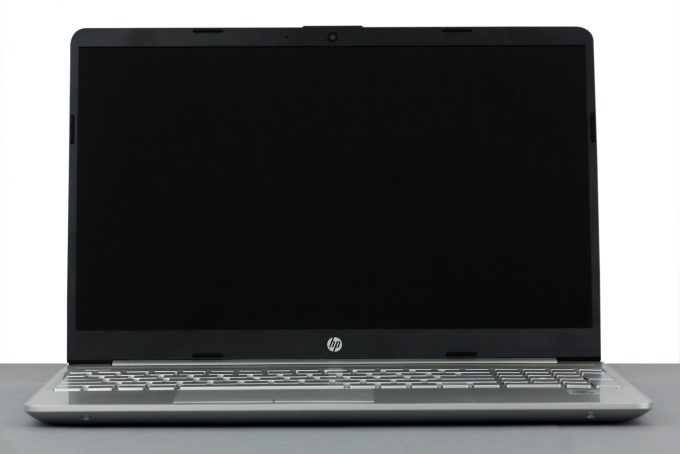
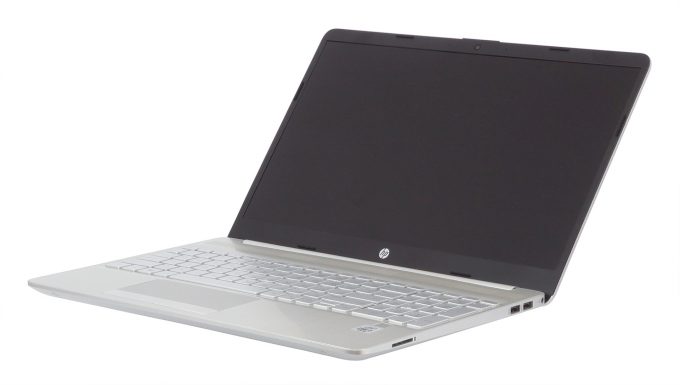
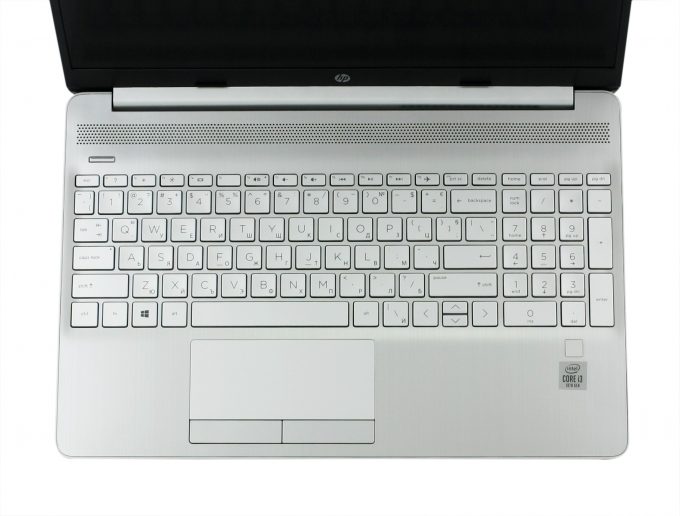
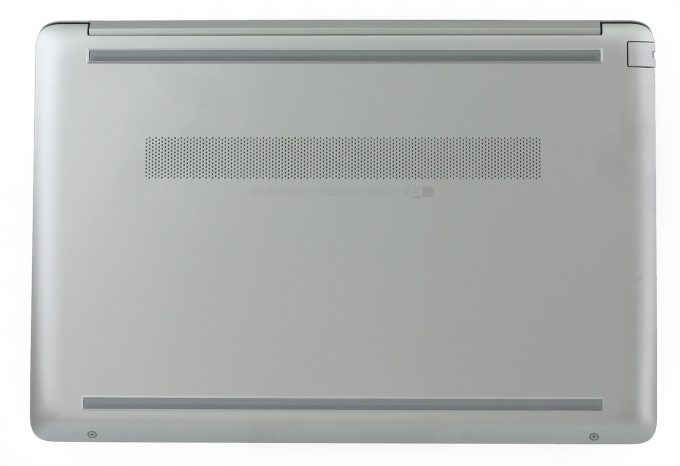


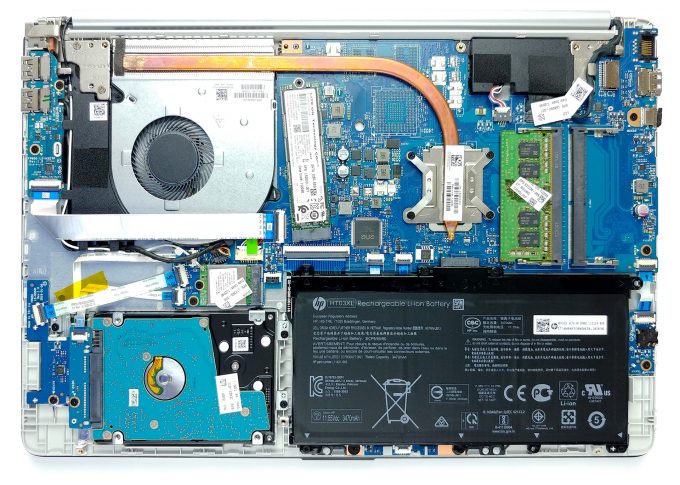
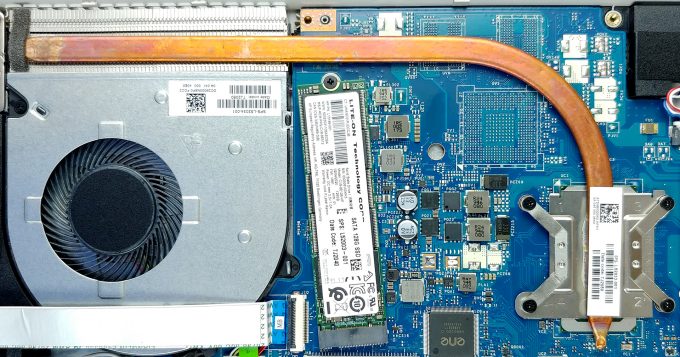
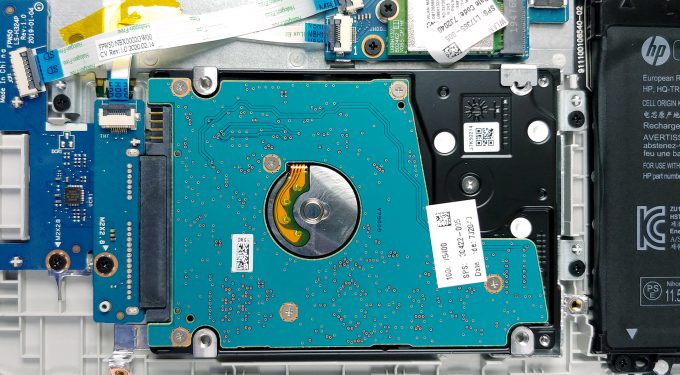

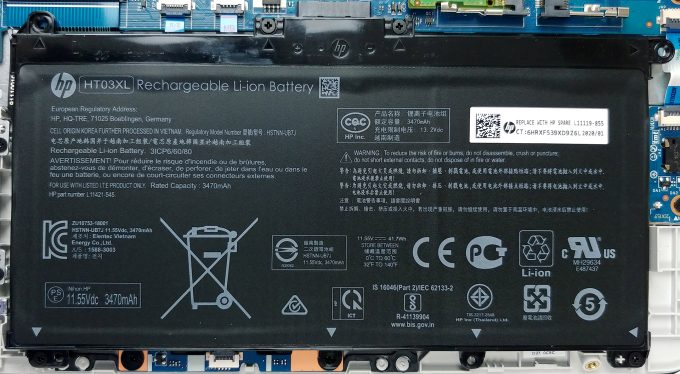
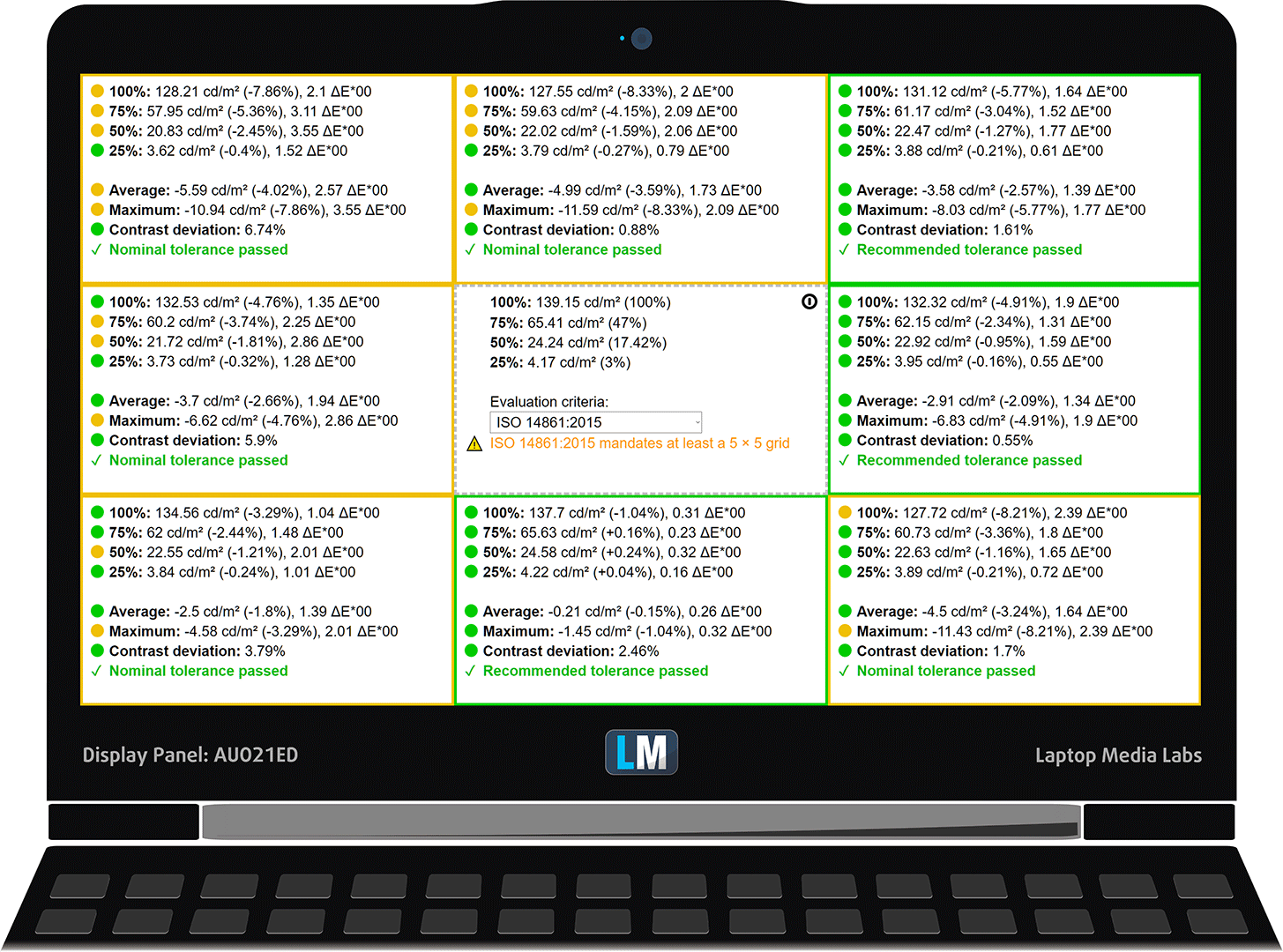

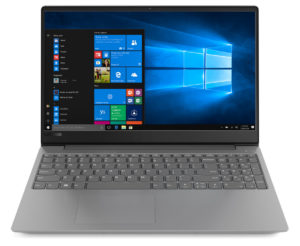








There is also a very similar model called HP 15-DW1000NT same chassis used but internals are quite different. (There is NT at the back.)